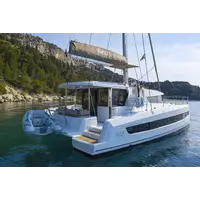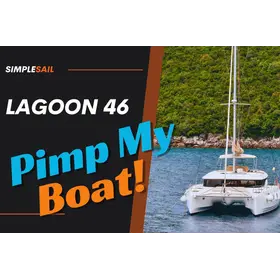Marine Knot: 28 Types
In this article we are going to talk about a vast number of options when it comes to tying marine knots so you could use the right knot for every particular situation. At your service are 28 knot schemes and description of for each one, as well as explanation of necessary terms and some history of how they all came to be.
- WHAT ARE SEA KNOTS AND WHAT ARE THEY FOR?
- THINGS TO CONSIDER FOR BEGINNERS BEFORE STUDY
- SCHEMES FOR TYING BASIC MARINE KNOTS
- Reef Knot
- Slipped Reef Knot
- Bow knot
- Carrick Bend
- Two Half-Hitches
- Round Turn and Two Half-Hitches
- Turn and Two Half-Hitches
- Fisherman’s Knot
- Tying Cables With Hitches
- Bowline Knot
- Bowline Upon the Bight Knot
- Kalmyk Loop
- Marlingspike Hitch
- Sheet Bend
- Double Sheet Bend
- Noose
- Running Knot
- Blackwall Hitch
- Cat’s Paw Hitch
- Knot for Reducing the Length of the Cable
- Figure-Eight Knot: The First Variation
- Figure-Eight Knot: The Second Variation
- Stopper Knot
- Boat Knot
- HISTORY OF SEA KNOTS
There are many excellent nodes used for a variety of purposes. Understanding nautical knots is useful not only on an ocean liner, but also on a sailing yacht, catamaran and other small vessels. Tourists who often go on long trips should also be aware of them.
What Are Sea Knots and What Are They For?
Knot weaving is a whole art form that appeared in antiquity. In addition to sailors, everyone should learn it, because this skill can be useful in daily difficulties and tasks. For example, all hitch variations allow you to quickly secure the rope to a stable support.
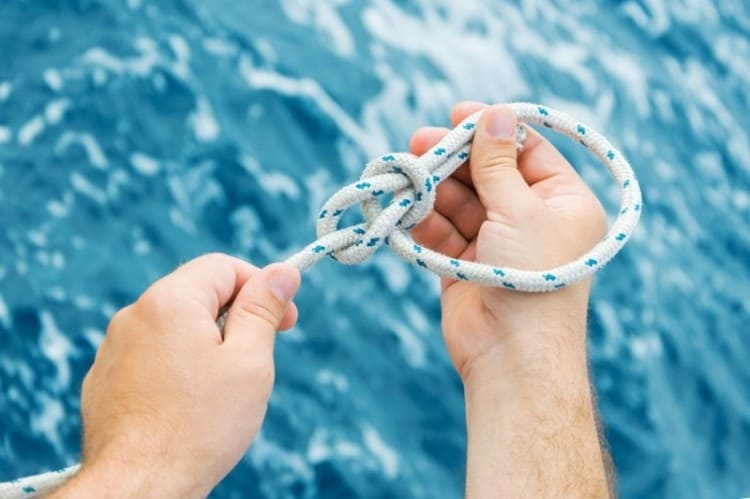
Marine knots are considered to be the strongest and most reliable
Benefits of marine knots:
- they connect parts of the same size;
- perfectly cope with sharp jerks and loads;
- do not disintegrate and do not slip, including after getting wet.
The sea knot must be tied extremely tightly and securely while also allowing to quickly untie it.
It is recommended to use ropes made from natural materials and threads, however, they will still get damaged over time.
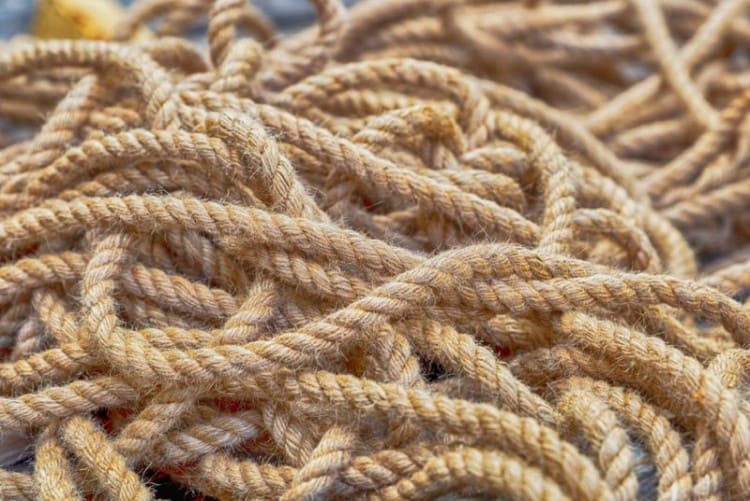
Ropes made from natural fibers should be used
Things to Consider for Beginners Before Study
Beginners should start by studying and memorizing special terminology, which is often used when describing knot schemes and manipulations, basic rules and commands.
You should also know the following terms - this will help you navigate in various literature on this topic, study it and gain new useful knowledge:
- Knot is an interlacing of the working and standing ends, or connected ends.
- Bend is a connection of the working ends of the cables to connect them into one.
- Hitch is the fastening of the working end on another subject.
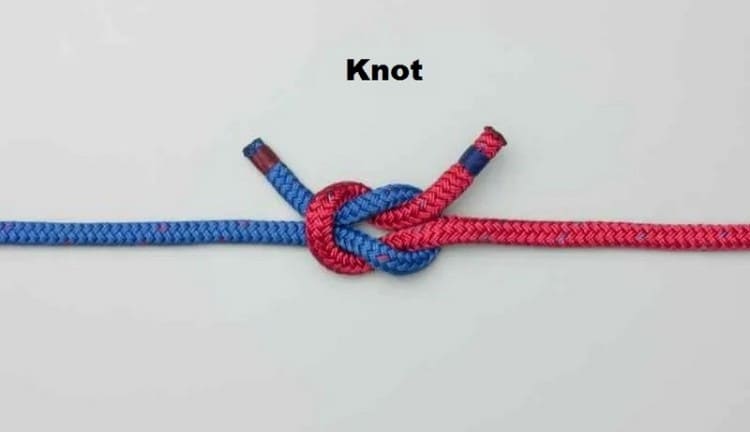
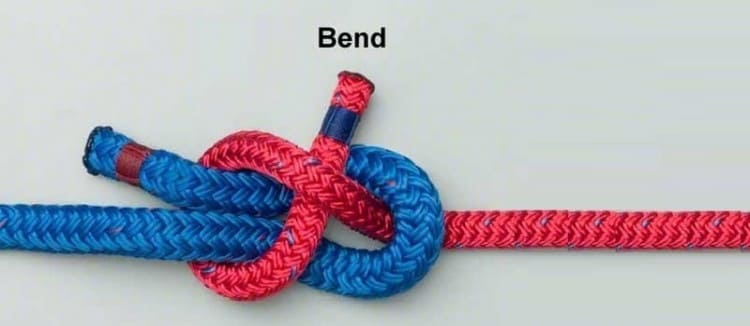
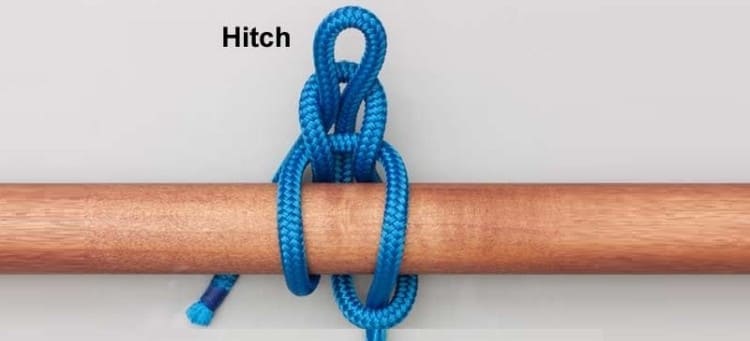
In addition to terms, you should pay attention to the basic tying schemes. You should start with bowline, figure eight, reef knots, a simple half-hitch and a hitch. After they are fully mastered, you can begin to study more complex knot variations that will require more skills and practice.
It is worth remembering that the strength of the knot depends on both the skill of the person and the strength of the rope. Therefore, you should carefully approach the selection of material for practical exercises.
The main thing in this matter is constant practice so that a quality knot is quickly tied even with eyes closed in any stressful situation. After all, this useful activity, among other things, has a beneficial effect on many qualities and characteristics of the human brain: including coordination and fine motor skills.
Schemes for Tying Basic Marine Knots
In the heyday of seamanship, approximately 4,000 types of sea knots were known. Only 700 of them have survived to the present day, the rest are irretrievably lost.
Before proceeding with the implementation of the main marine knots, let's define some basic concepts:
- the standing end is the extreme end of the cable, which is fixed motionless;
- working end - the loose end of the cable, from which all knot knitting algorithms begin;
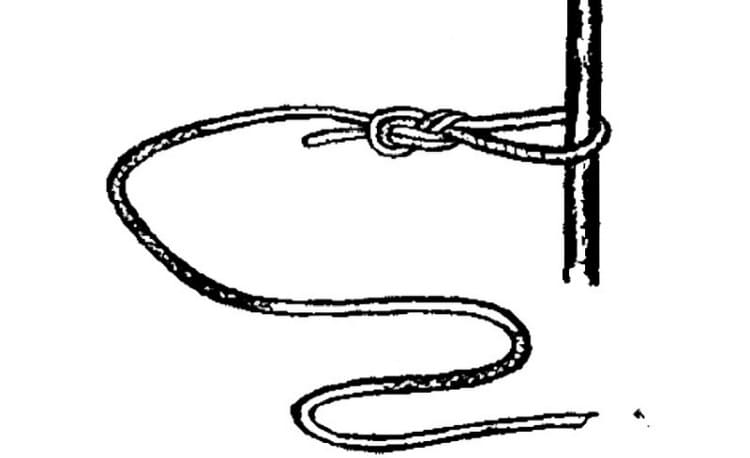
- overhand - a working or standing end folded in half;
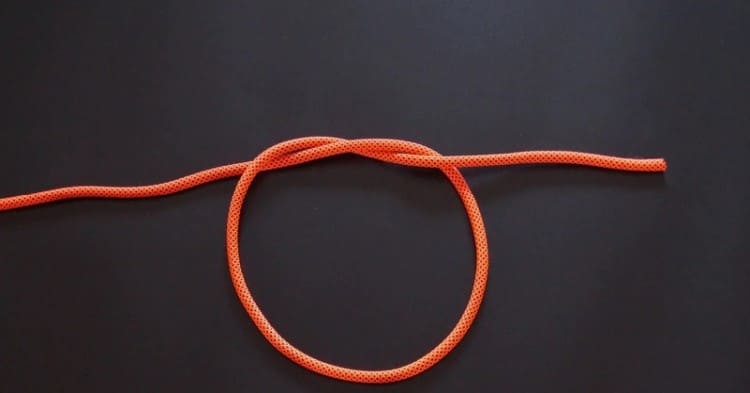
- peg - a loop of rope ends that intersect with each other;
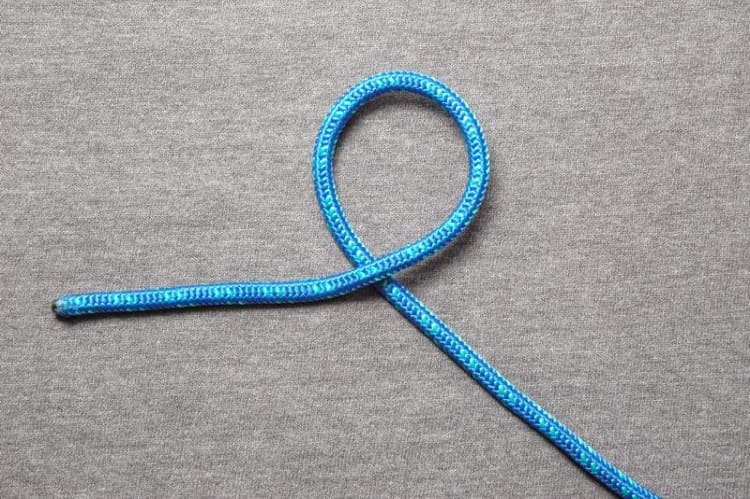
- half-knot - the ends of one or different ropes that overlap each other;
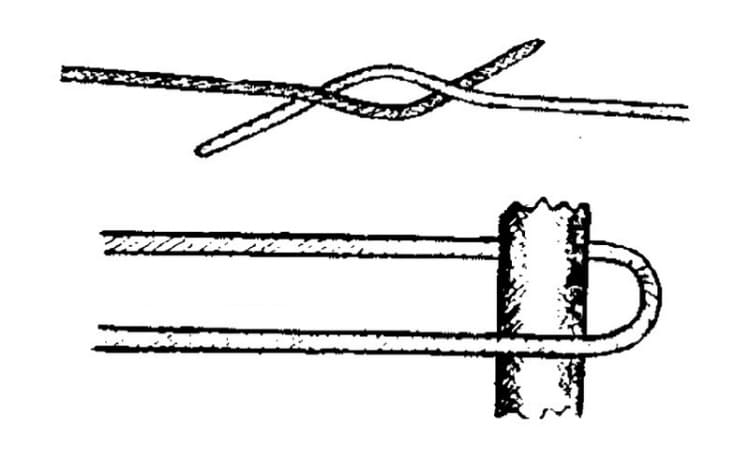
- turn - part of the cable, which is wrapped around an object, the ends of which do not cross;
- round turn - a turn of the cable around an object or other rope, the ends are directed in opposite directions.
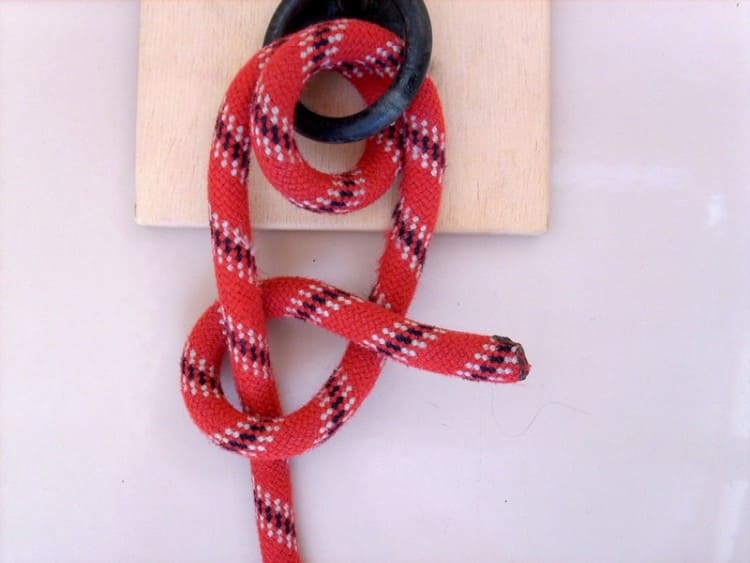
Tourist knots are classified and differentiated by their application or by the material used in them:
- Stopper knots, with a thickening at the end, connecting the standing and working ends. In particular, they help to keep the safety channel in the stopper in order to resist slipping.
- Anchor knots that secure the working end of a rope to another rope or object. For example, to secure the flag or mooring in specialized harbors.
- Binding knots connecting ropes that are different in diameter. For example, they are applicable when stopping for a stretch near the shore, if the length of the rope with which the vessel is tied to the berth is insufficient.
There are several more varieties: decorative and special. In addition, self-tightening knots are also used, which strengthen when loaded, and non-slip ones that retain their original shape.
Reef Knot
This is one of the oldest methods of joining cables or ropes that are equal in diameter. The reef knot is also called the "Hercules" or "granny" knot. A very popular weaving option, but not at all safe: with a huge pull or after getting wet, it begins to slide, fall apart and untie.
Sometimes, to prevent untying, a wooden tab is inserted into the loops. However, reef knot should not be practiced in mountaineering, hiking and other dangerous activities.
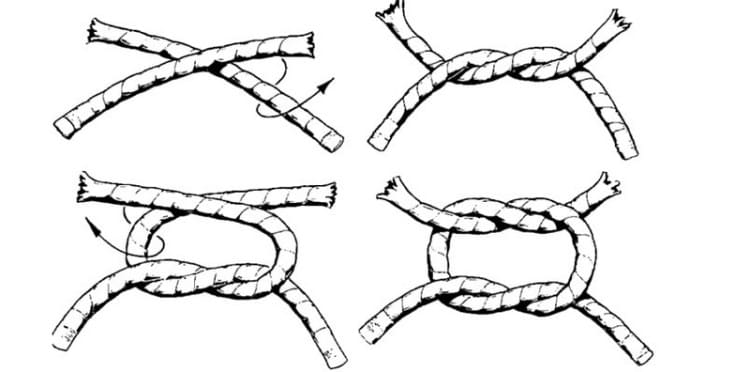
It is not difficult to tie a reef knot, but it can only be used with small loads on the rope.
To tie a knot in this way, you need to take two ropes and cross them in such a way that a half knot is formed. Then you should cross them again and tighten both ends. Additionally, it can be strengthened with several half-knots.
Slipped Reef Knot
The knot got its name from the fact that it’s often used to connect the ends of sail ties. Moreover, it is practiced to combine rigging of the bags for carrying dinghies, compasses, and in other circumstances when it is necessary that the fastening is reliable, but can be simply untied.
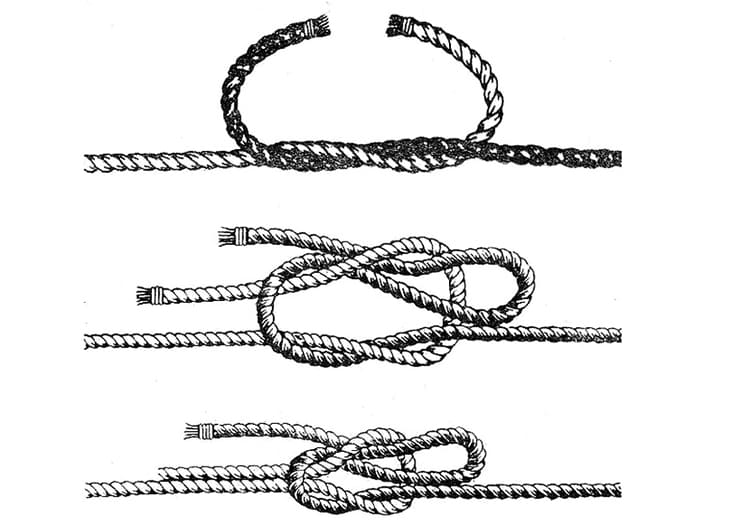
The slipped reef knot is used in situations where secure fastening and quick release are required.
The principle of slipped reef knot is similar to reef knot. You should pick up the two ends of the cable and make the first half knot. Then start tying the second, at this time the working end folded in half, threading it into the loop. The other working end, which remains straight, should come out on the same side as the lower one.
Bow knot
A similar method is practiced when necessary to connect the cables with a huge load applied.
To form it, you will have to wrap the end of one rope 2 times around the other, then bend the end towards each other and repeat the previous step.
Then, the pattern is pulled, and the ends are attached with a single-strand or double-strand cable made of plant material.
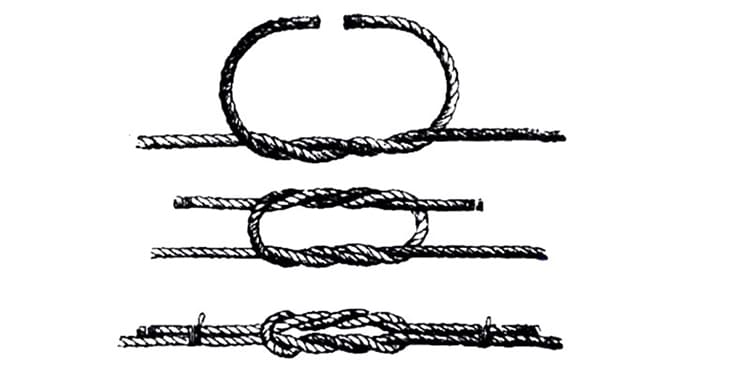
The bow knot is much stronger than a reef knot.
Carrick Bend
It is utilized to combine cables that are different in diameter. Ropes of similar thickness can also be tied with it, often required when the connection must withstand increased traction or getting wet. For ease of formation, cables are usually placed on a horizontal surface:
- On one rope, it is necessary to form a loop by laying the short end of the rope under the standing end.
- The second rope should be laid under the first, then over it, and at the end, bring the second under the end of the first.
- Further, the end of the second is threaded into the loop and passed under itself.
- As a result, to fix the knot, it is necessary to pull both standing ends.
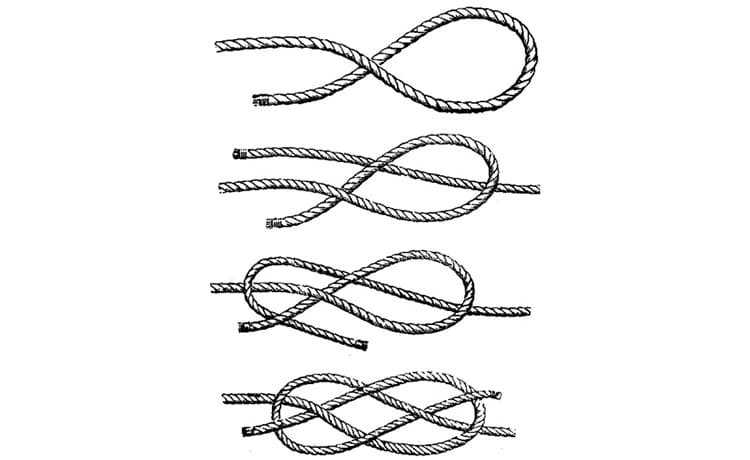
The Carrick bend is used to tie ropes of various sizes and diameters together.
Additionally, you can strengthen the weaving with a single-strand or double-strand cable made of plant material.
Two Half-Hitches
This knot is used if it is necessary to fasten mooring cables to berths or perform towing. It is indispensable for securing the vessel, therefore it is considered an extremely important non-slip marine knot. It is able to withstand a huge load of several tons. Nevertheless, the pattern is easily untied.
To tie this marine knot, you need to:
- Make a loop around the anchor point.
- Pass the rope through the loop formed, and it does not matter if the free end is passed above or below the rope. It’s only important that that the passing is performed each time from the same side.
- Next, a loop is made around the rope, and the free end is again passed through the resulting loop.
- As a result, it is necessary to secure the end with a single or double strand rope made of plant material.

Two half-hitches knot is used to fasten the mooring cable to the pier.
If maximum reliability is required, two half-hitches can be completed with a control knot.
Round Turn and Two Half-Hitches
This weave is similar to a standard two half-hitches, but differs by a complementary round turn around the mount. It is often practiced for long-term mooring due to its reliability. To tie it, you will have to encircle the working end of the rope 2 times around the mount, then tie the standing part with half hitches and secure it using a single-strand or double-strand cable.
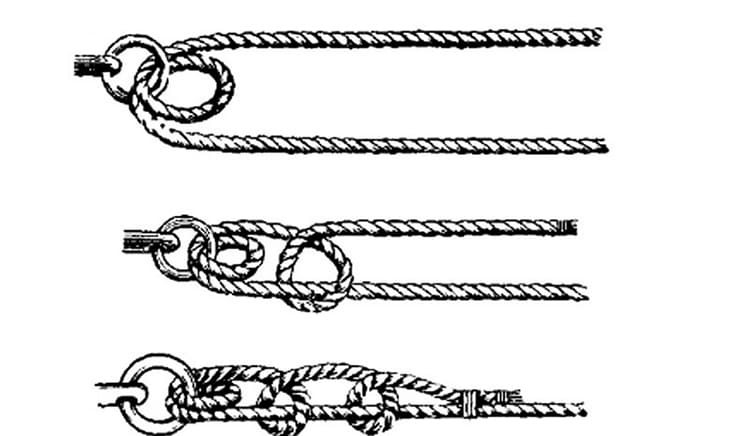
Round turn and two half-hitches with a hose is used when fastening mooring lines.
Turn and Two Half-Hitches
With this knot, cables are attached to rings or supports, ropes are attached to brackets of auxiliary anchors, and safety nets are applied to cargo hatches.
To tie it you should:
- Pass the end of the twine into the fastening ring or wrap around the support.
- Then it is necessary to go around the main rope with the threaded end and thread it into the mounting ring.
- After from the same end, form a loop around the main rope.
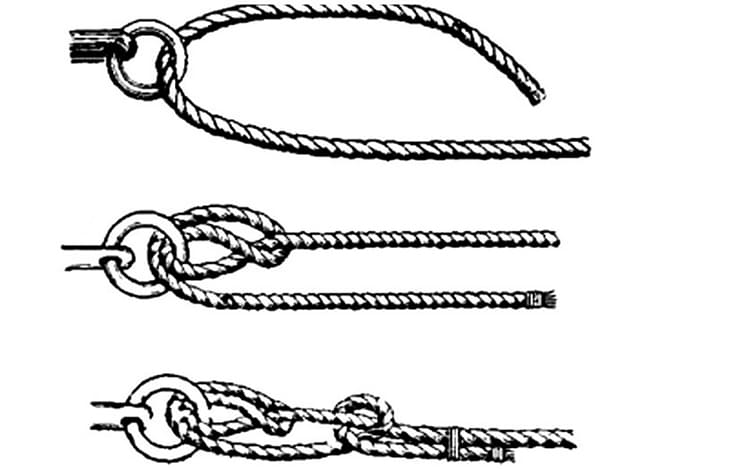
Turn and two half-hitches is used for attaching nets to hatches.
As a result, the working end is tied to the standing part with to a single-strand or double-strand cable.
Fisherman’s Knot
Another name is angler’s knot. This is the most famous and extremely strong knot, used to strengthen the cable at anchor and for other purposes. Similar to a regular round turn and two half-hitches:
- The end of the rope is pushed into the ring 2 times, the second round turn remains free.
- The end of the rope should be laid over the standing end and plugged under the free-lying round turn so that the first half-hitch can be tied.
- Continue wrapping the standing end and make the second half-hitch.
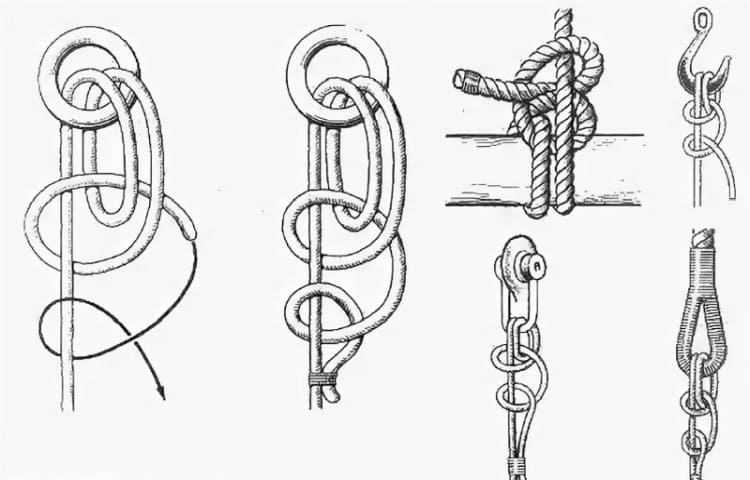
The fisherman’s knot is useful for securely fastening various devices.
At last, tighten with a single-strand or double-strand cable.
Tying Cables With Hitches
There are several methods for executing such a knot.
First way:
- The end of one cable must be folded like an overhand and the standing part must be strengthened with two or three half-hitches.
- Then the end of the second one is inserted into the loop, which must also be tied to the standing part with half hitches.
- The ends are reinforced with a single-strand or double-strand cable.
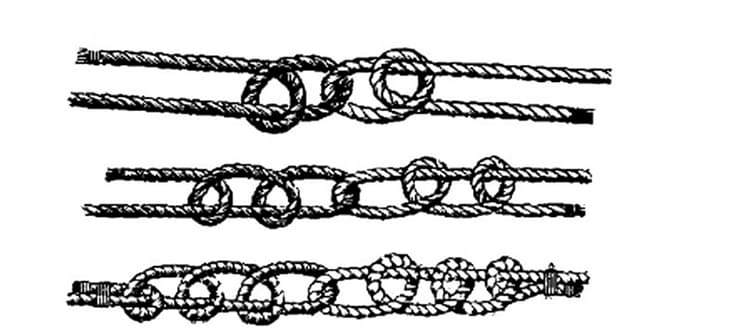
Tying cables with hitches is used to fasten two ropes.
The second method is based on attaching the end of one cable to the second with three half-hitches, and wrapping the end of the second around the first with half-hitches.
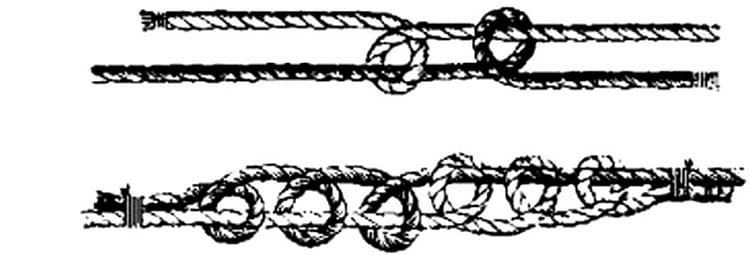
The second method of tying cables with hitches.
Clove Hitch
These knots were used by sailors on sailing ships in order to weave a structure similar to a ladder, along which it would be possible to move along the shrouds. It was them who figured out created such a knot that could be formed using one hand.
This is a particularly secure and tight knot. They resort to it, if necessary, to tie the line to the shrouds, to fix the rope to the shroud, or to tie the line between the vessel and the pier.
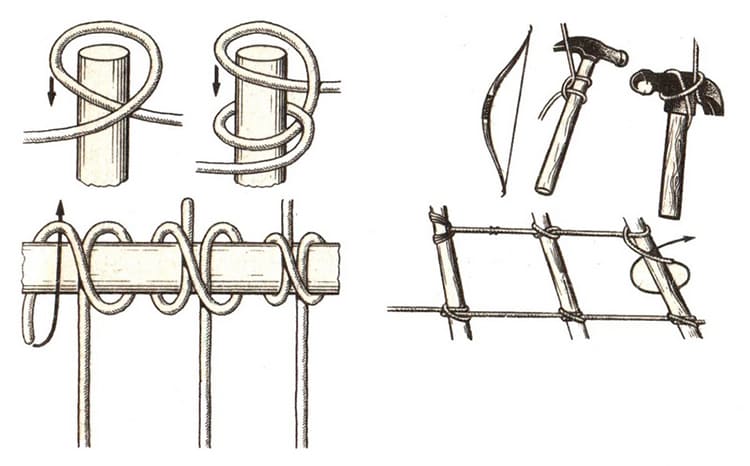
Clove hitch is considered one of the most reliable knots.
In particular, this knot is practiced for tying cables for non-rough objects without protrusions. Extremely popular in circumstances where the load is the same on both sides, otherwise the knot may become untied.
A loop is made on the cable, and a second one next to it. It is put on top of the first, then both are put on the support. As a result, a knot is formed by tightening the ends.
Mooring Knot
Also known as round turn clove hitch, but in that case, it has 3 round turns wrapping around the object instead of two. It is used when lifting wood and other heavy loads.
To form it, the working end, it is wrapped around the support 2 times, both round turns are crossed, then they surround the object again and are held under the crossing round turn.
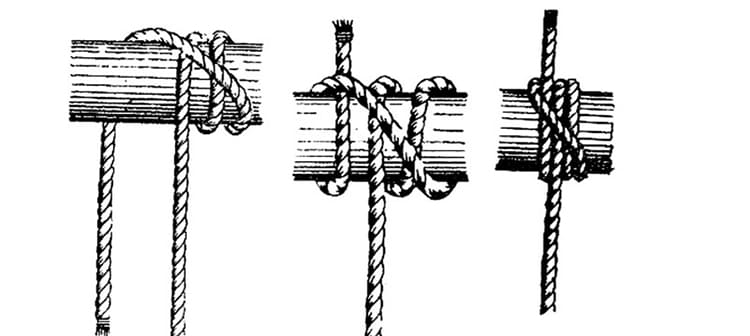
Retractable hitch is useful for lifting massive building materials.
Bowline Knot
Another name is King of the knots. It is considered standard, because it contains parts of various marine knots. Extremely dense and strong, you can turn to it for safety, mooring, fixing ropes to the hook and other purposes. You can take cables of any diameter and made of arbitrary materials.
To get such knot, a small loop is made on the rope, keeping a small section of the rope the size of the future knot. Next, the end of the rope is threaded through the loop, and then wrapped around the free end and threaded back into a small loop.
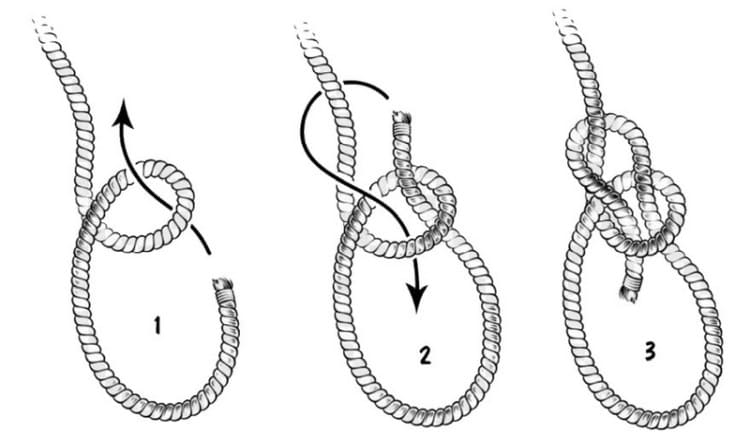
Bowline - one of the most necessary knots on the ship.
Untying is done quite simply, but not on its own: you will have to move the loop of the working end in relation to the slightly released standing end.
Bowline Upon the Bight Knot
It is considered a replacement for a bowline when working on masts and overboard.
For its formation it is necessary:
- Form an open loop in the middle of the rope.
- Then fold it in the form of a closed loop and thread the end of the open loop through the closed one.
- After that you need to take out the loop and circle it around the entire knot until the loop completely wraps the knot to the standing ends.
All that remains is to tighten it.
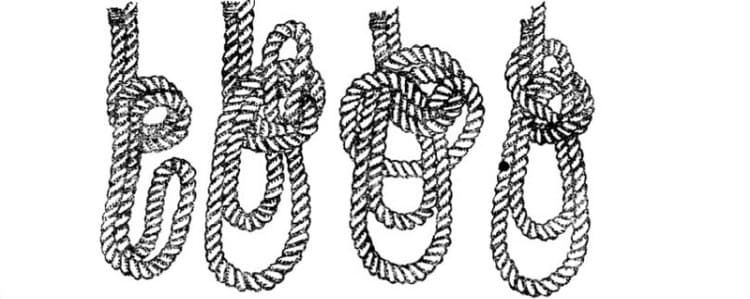
Bowline upon the bight knot is used for work on the mast and overboard.
Kalmyk Loop
Useful when transferring tools, buckets, brushes and other objects to a needed height.
Here's what the principle of tying it looks like:
- A loop is made at the working end of the rope, and then another one in the opposite direction.
- Next, you need to stretch the working end of the rope into the first loop, then fold it in half, stretch it into the half ring of the first loop closest to it.
- As a result, the second loop is put on the support, and is pulled over the standing end.
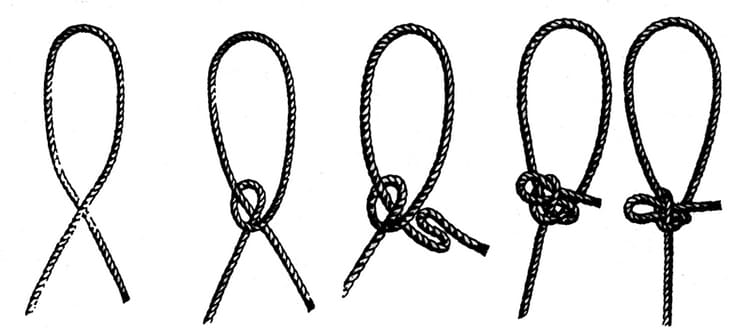
The Kalmyk knot is famous for its high strength, practicality and reliability.
Marlingspike Hitch
It is practiced to bring tools to the worker on the mast or overboard. In addition, it will be useful for strengthening the cables for supports that are wound between the side and the berth during the ship's mooring.
- It is necessary to fold the rope in such a way that its working end passes under the standing one, forming a loop.
- After that the working end is folded in a coil and threaded into the resulting loop.
- To prevent the coil from popping out, a pile or any object that should be fixed on the rope is inserted into it.
- Fixing the weak spot, finally tighten the knot.
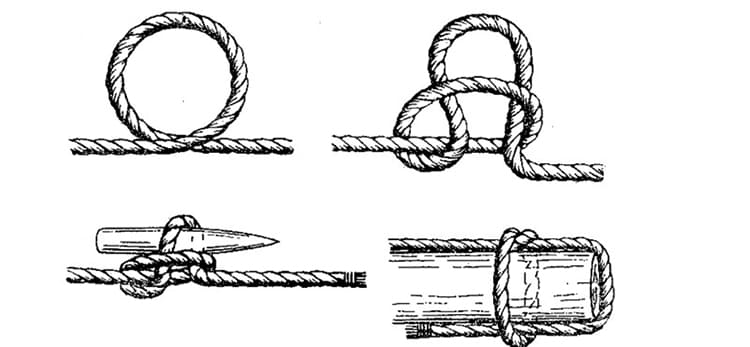
The Marlingspike hitch will help to moor the vessel to the piles on the pier.
Sheet Bend
A sheet bend is performed if it is necessary to strengthen the cables, one of which has a permanent loop or teardrop-shaped mandrel made of metal. Also, it is utilized to fix safety ropes to the signal flags.
To form it, a loop is made on a wider rope. A narrow rope is threaded through it, then wound up at the end of the wide one and behind the main end. It ends with threading a narrow rope under the loop.
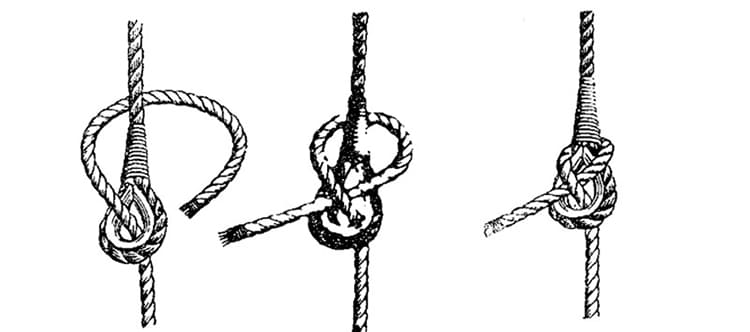
Sheet bend is one of the main rope knots.
Double Sheet Bend
The practical application of this node is similar to the previous one. However, it is the most reliable, and therefore it is more popular when manipulating sails, rigging and anchor chains.
How to tie a double sheet bend:
- A loop is made on a wide rope, a narrow rope is threaded into it, and its free end is wound around a wide loop.
- A full circle is performed, and after that the free end of the narrow rope is brought under itself.
- After the next turn, the free end is removed and fixed in place with control knots.
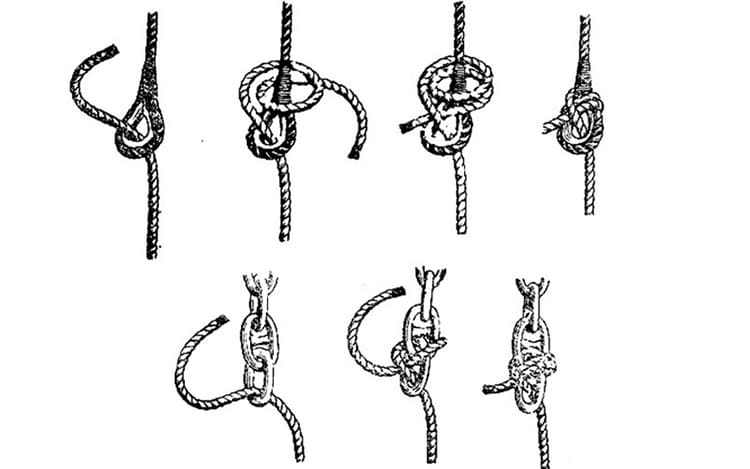
Double sheet bend is necessary for interaction with rigging and sails.
Noose
A noose knot is used to tow and move wood and other objects on board. It is formed so that the working end is braided around the object, forming a loop. Next, at least three turns are performed with the free end around the working part of the rope, and at the end of the control knot.
There are many types of noose knot, performed in straight, flat and fishing versions.
For example, for professional climbing equipment, the tensionless hitch is especially known. In this case, the working end is attached to the carabiner with a figure-eight connection, and the remaining part of the rope, if desired, is passed through the carabiner around the support.
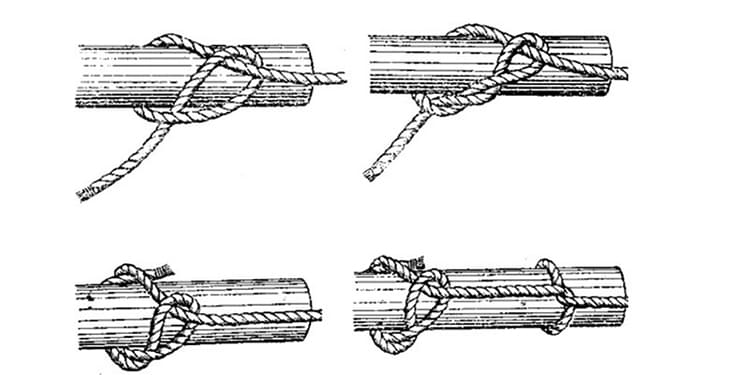
Noose knot is used when transporting logs to land and ship.
If it is necessary to perform a noose on the support, then you should wrap the support with a rope, bring it into the loop and wrap it around three times, then thread it into the small loop. The result is a strong bond that can even withstand getting wet.
To increase the reliability of the noose, you can perform a complementary round turn.
Running Knot
A similar option is used to temporarily secure the cable to floating objects. The cable is laid in the form of two loops of similar diameter. The working part is wrapped around them in several turns, and then its remainder is wound into a loop along the standing part. It is not difficult to untie the knot, you just need to pull the standing part of the cable.
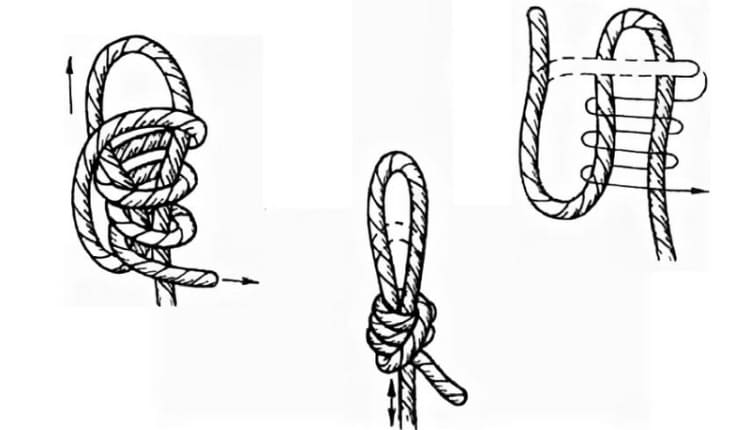
The running knot is used as a fastener to lift an object out of the water.
Blackwall Hitch
It is mainly practiced to strengthen wide cables on the hook. It is able to contain the average load of the cables.
The end of the rope, pre-wrapped around the back of the hook, is placed inside the hook and covered from above with the standing part of the rope. As a result, the working end is reinforced with a single-strand or double-strand cable. This technology simplifies the weaving on any section of the cable.
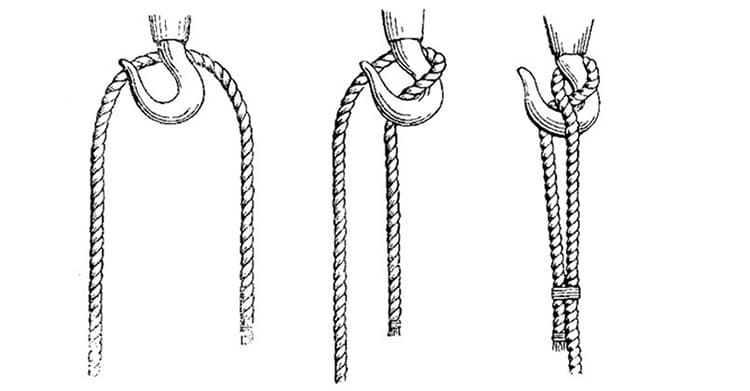
The blackwall hitch is suitable for light loads.
Towing Knot
Practiced to strengthen the towline on a hook or support. In this case, it becomes possible to quickly release or pull the towing cable.
To form it, the rope bends around the object. Its end winds up under the main part of the rope and goes around the object again – after that we repeat this step. As a result, the working end is fixed with a single-strand or double-strand cable.
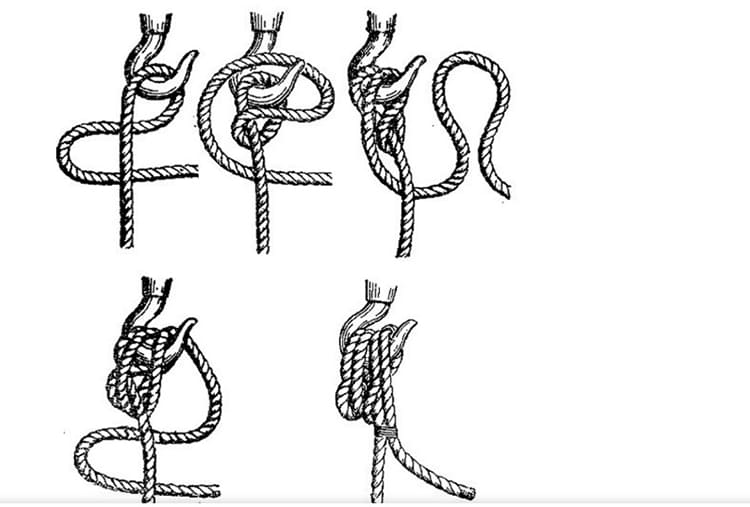
The towing knot is used to attach the cable.
Cat’s Paw Hitch
Used to slightly shorten the lifting sling. To do this, fold the cable in half and pull its end so that two loops are obtained. After that, they are simultaneously twisted in opposite directions several times and put on a hook.
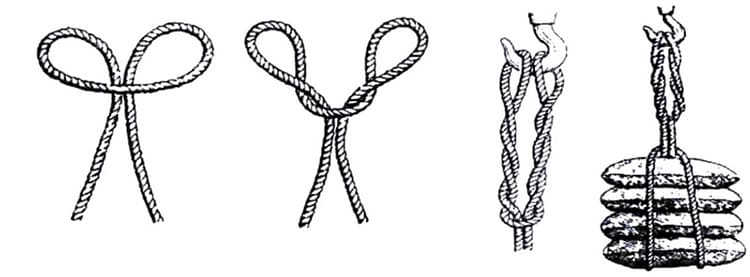
The cat's paw knot allows a relatively small reduction in the length of the sling.
Knot for Reducing the Length of the Cable
The cable to be shortened is folded in half to form two loops, then each of them is pulled together with a half-hitch and fastened to the cable with a single-strand or double-strand cable.
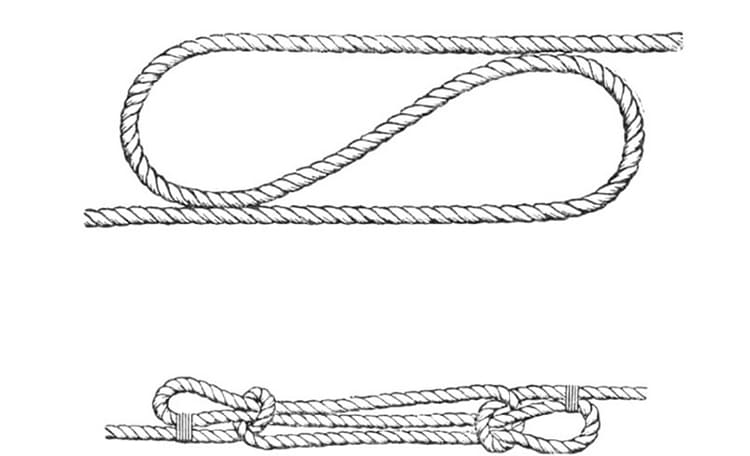
Knot for reducing the length of the cable serves to shorten the rope.
Figure-Eight Knot: The First Variation
A knot that got its name due to its characteristic shape. It is the basis of many fasteners and it mainly acts as a stopper and a fixing knot for the hook and various supports. Its main advantage is the ease of tying and untying, even if the cable gets wet.
For example, on sailing yachts, the figure eight is used as a stopper and anchor knot. It can also be used to make bucket handles or sledge ties, tune guitar strings, or perfect a dog leash.
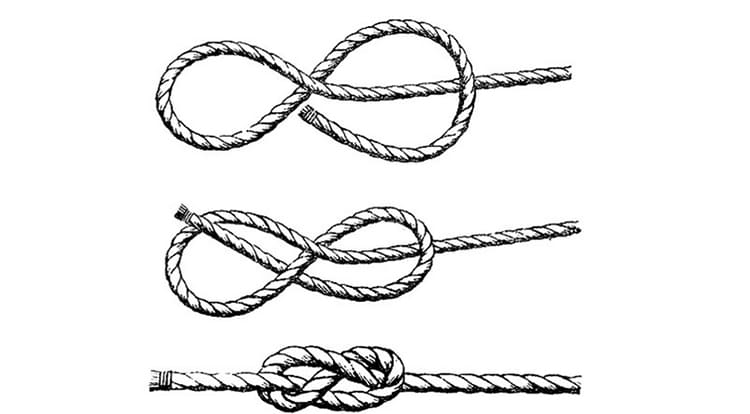
Scheme for tying the figure-eight knot.
The rope is folded in half, forming a loop. At its base, the ends of the rope overlap each other, and the lower part winds up behind the upper, forming a figure eight.
Figure-Eight Knot: The Second Variation
It is very similar to the previous knot, however, in this case, the end of the cable is turned around the standing of the cable twice in advance. The purposes of use also coincide with the standard eight.
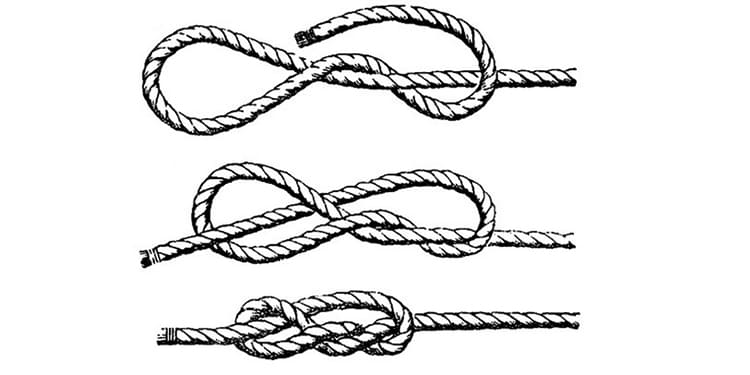
The second way to tie a figure-eight knot.
Stopper Knot
It is applied on the cable with the help of two round turns, then the working end is wrapped around the cable 2-4 times in the direction of pull and attached to it using a single or double thread cable. Moreover, the stopper can be applied on the cable both in the direction of the descent of the cable, and against this direction.
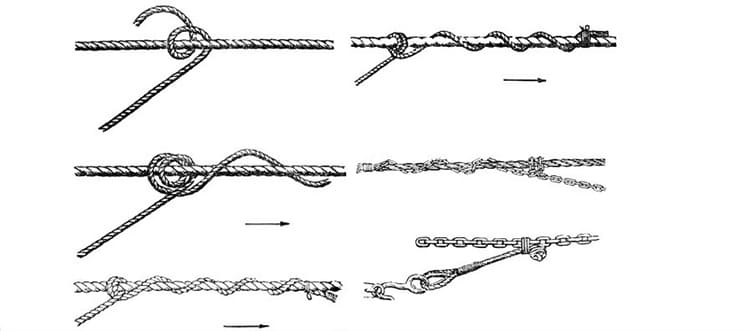
The stopper knot can be applied in different directions along the rope.
Cable Fastening on Bitts
The mooring, or towing, cable is drawn between the bitts (paired mounts), then it is alternately wrapped around them in the shape of a figure eight. In general, it is recommended to apply three to five eights on the bitts.
In the same way, the upper round turns, which are applied on the bitts, are tied using a strong single-strand or double-strand cable, its ends must be tied with a slipped reef knot.
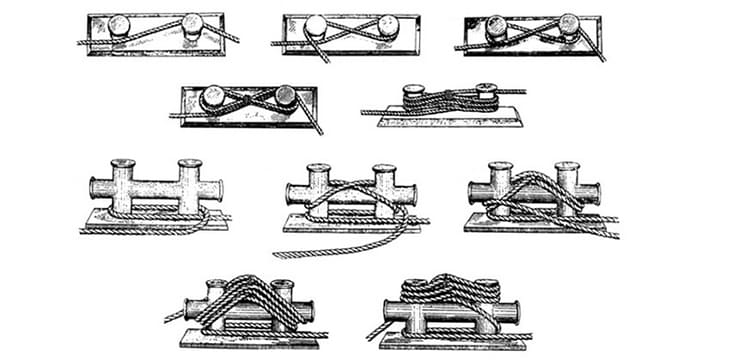
The knot is used for mooring to the pier bitts.
Boat Knot
Such knot is used to secure the cable when towing a boat.
To tie it, you need to:
- Thread the working end of the cable into the bow ring of the boat and pass it under the first thwart (a board used to strengthen the boat).
- After that, the working end is wrapped around the second thwart, held under the cable, crossing it, and again passed under the can.
- As a result, a loop is formed from the end of the cable and is brought under the round turn encircling the thwart.
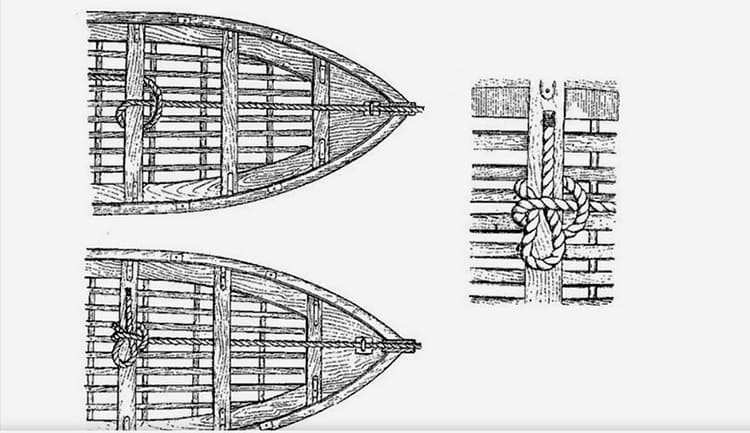
The boat knot is used to tow the boat.
History of Sea Knots
People began to knit knots long before the first fire production and even more so before the advent of the wheel. They were made from fibers, stems or tendons of animals. Through their use, tools were fixed in place, pets were restricted in their movement, fishing nets were made, and the first boats and huts were invented.
Sea knots common today are even found on the "ships of the dead" in ancient Egypt - funerary boat models that are more than 5,000 years old.
Archaeologists managed to find gazebo knots on the surviving gear of the ship of Pharaoh Cheops, and on one of the doors that leads to the tomb of Pharaoh Tutankhamun, the so-called clove hitch.
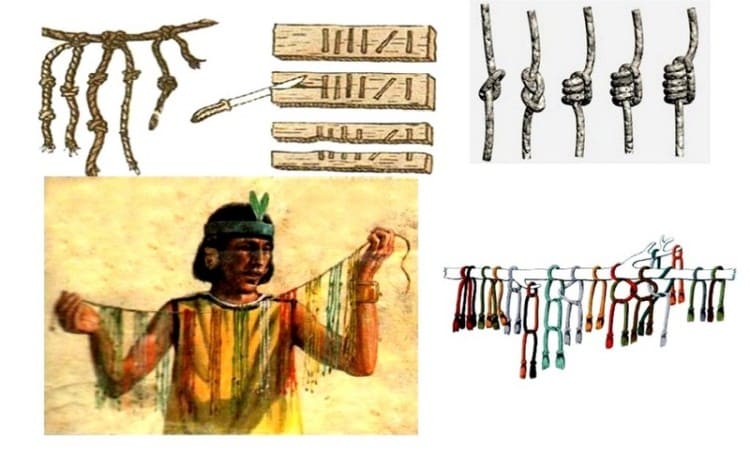
Knot tying is one of the oldest inventions of mankind.
With the development of sailing, the knot weaving technique gained even more popularity. Even then, the first systems of knot connections for reliable fixation of ship equipment began to be created.
Marine knots are extremely strong, so they began to be used not only by sailors, but also by people of various professions. Knots continue to change and further improve. The popularization of tourism, especially mountaineering, played an important role in this.
Do you use sea knots in everyday life? In what situations? Share your experience in the comments.


